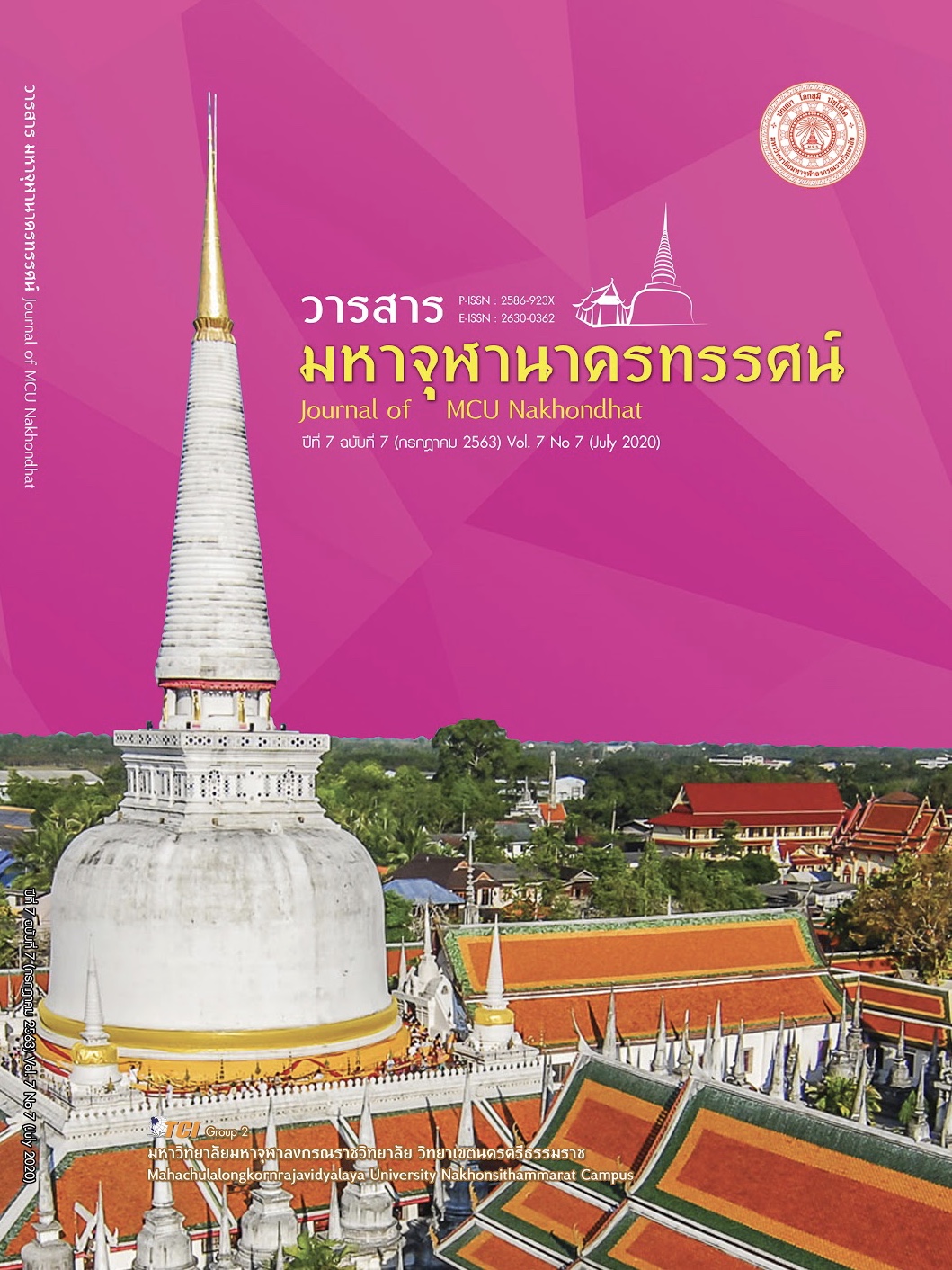RESULTS OF CONDUCTING LEARNING ACTIVITIES BASED ON THE CONSTRUCTIVIST THEORY TO ENHANCE MATHEMATICAL LITERACY FOR MATHAYOMSUKSA 4 STUDENTS IN CONIC SECTION
Main Article Content
Abstract
This research is an action research. The objective is to develop the mathematical literacy of Mathayomsuksa 4 students in conic section by using Constructivist Theory Model to pass the criteria of 60 percent of the full score. The target group was 28 students of mathayomsuksa 4 students in the academic year 2019 from Borabu School, Borabu, Mahasarakram. They were selected by using Purposive Sampling for 1 classroom. The research instruments are 3 lesson plans of Constructivist Theory Model, 4 lesson plans of Constructivist Theory Model with KWDL technique, 3 lesson plans of Constructivist Theory Model with KWDL technique focus on group activities, 3 sets of mathematical literacy ability test and mathematical literacy ability observation form. The data was analyzed by using mean, percentage and standard deviation.
In the research, it was found that: The mathematical literacy score of mathayomsuksa 4 students by using Constructivist Theory Model as the following. In the first, second, and third spirals, the averages are 59.04 percent, 68.30 percent, and 78.13 percent, respectively. Especially, for the third spiral, each of the student’s scores is higher than 60 percent of the full score. Moreover, the mathematical literacy score is increased in every spiral.
Article Details
References
เวชฤทธิ์ อังกนะภัทรขจร. (2555). การประยุกต์ใช้แนวคิด Teach Less, Learn More (TLLM) สู่การจัดการเรียนรู้ในชั้นเรียนคณิตศาสตร์. วารสารศึกษาศาสตร์ มหาวิทยาลัยบูรพา, 23(1), 1-11.
ปรีชา เนาว์เย็นผล. (2537). หน่วยที่ 12 การแก้ปัญหาคณิตศาสตร์ ประมวลสาระชุดวิชาสัตถะและวิทยวิธีทางคณิตศาสตร์ หน่วยที่ 12 – 15. กรุงเทพมหานคร: มหาวิทยาลัยสุโขทัยธรรมาธิราช.
ปรียา สิถิระบุตร. (2557). การพัฒนาทักษะการแก้ปัญหาเรื่อง การคูณ การหาร สำหรับนักเรียนชั้นประถมศึกษาปีที่ 4 ด้วยการจัดการเรียนรู้โดยใช้เทคนิค KWDL ร่วมกับการวาดรูปบาร์. ใน วิทยานิพนธ์ครุศาสตรมหาบัณฑิต สาขาวิจัยและประเมินผลการศึกษา. มหาวิทยาลัยราชภัฎอุบลราชธานี.
รัศมี สุจินพรหม. (2543). ผลของการใช้แผนการจัดกิจกรรมให้นักเรียนสร้างองค์ความรู้ที่มีต่อการพัฒนากระบวนการคิดและผลสัมฤทธิ์ทางการเรียนวิชาคณิตศาสตร์ ของนักเรียนชั้นประถมศึกษาปีที่ 3 โรงเรียนบ้านบุทม จังหวัดสุรินทร์. ใน วิทยานิพนธ์ศึกษาศาสตรมหาบัณฑิต สาขาศึกษาศาสตร์. มหาวิทยาลัยสุโขทัยธรรมาธิราช.
วัลลภา อารีรัตน์. (2532). การสอนคณิตศาสตร์ระดับประถมศึกษา. ขอนแก่น: คณะศึกษาศาสตร์ มหาวิทยาลัยขอนแก่น.
วิชาการโรงเรียนบรบือ. (2562). สถิติผลคะแนนสอบ O – Net ของนักเรียนชั้นมัธยมศึกษาปีที่ 6. มหาสารคาม: โรงเรียนบรบือ.
วีระยุทธ์ ชาตะกาญจน์. (2558). การวิจัยเชิงปฏิบัติการ Action Research. วารสารราชภัฏสุราษฎร์ธานี, 2(1), 29-49.
สถาบันส่งเสริมการสอนวิทยาศาสตร์และเทคโนโลยี โครงการ PISA ประเทศไทย. (2557). รายงานการ ประเมินผลการเรียนนานาชาติ PISA 2006 ความรู้และสมรรถนะทางวิทยาศาสตร์สำหรับโลกวันพรุ่งนี้. กรุงเทพมหานคร: สถาบันส่งเสริมการสอนวิทยาศาสตร์และเทคโนโลยี.
สุดา เขียงคำ. (2546). การพัฒนากิจกรรมการเรียนการสอนคณิตศาสตร์ ชั้นประถมศึกษาปีที่ 5 เรื่อง เศษส่วน ตามแนวคิดทฤษฎีคอนสตรัคติวิสต์. ใน วิทยานิพนธ์ศึกษาศาสตรมหาบัณฑิต สาขาหลักสูตรและการสอน. มหาวิทยาลัยขอนแก่น.
Brooks, J. G. & Brooks, M. G. (1993). The case for Constructivist Classrooms. New York: Association for Supervision and Curriculum Development.
Bussiere, P. et al. (2001). Measuring up: Performance of Canada’syouth in Reading. Mathematics and Science: OECD PISA Study – First Results for Canadians Aged_15. Ottawa, On: Statistics Canada.
De Lange, J. (2003). Mathematics for Literacy. In Quantitative Literacy: Why Numeracy Matters for School and Colleges. Madison.
OECD. (1999). Measuring Student Knowledge and Skills: A New Framework for Assessment. Paris: Author.
Underhill, R. G. (1991). Two layers of constructivist curricular interaction. In E. von Glasersfeld (ed.), Radical constructivism in mathematics education. (pp. 229 – 248). Dordrecht, The Natherlands: Kluwer Academic.
Von Hagen, J. et al. (2002). Quality and Success of Budgetary Consolidation in Buti, M. et al. (eds.). The Behaviour of Fiscal Authorities – Stabilization, Growth and Institutions. London: Palgrave.


